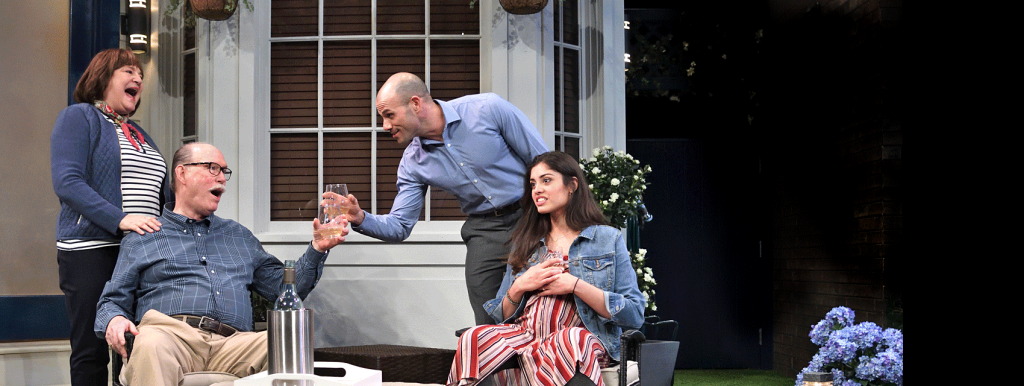Daniel Duque-Estrada as Segismundo and Alfredo Antillon as Astolfo in Sueño. Photo by Mark Turek.
Article by Tina Langill
They fight.
It’s the moment that words no longer serve and the characters enter into physical violence. Often, there is little to no deeper description of the fight in the script, and some dialogue continues until “He dies” or “She falls”, but the interpretation of these simple stage directions can color a story, its characters, and their world.
The history of choreographed fights as entertainment can be found in tribal dances thousands of years old, in cultures around the world. Single or multiple “combatants” would perform rehearsed movements, often to retell great historical battles or conflicts. Combat as entertainment had perhaps its most gruesome incarnations in the Roman gladiatorial battles that pitted captives, slaves, and live animals against trained fighters for the entertainment and distraction of the masses. Later in history, members of the European courts would duel for entertainment, as well as “honor”. The injuries and deaths that resulted eventually lead to the outlawing of duels and the invention of sport fencing, where one could more safely practice the skills of combat with bunted weapons. In Japanese history, Kenjutsu (the art and technique of the sword) followed a similar evolution, with wooden and bamboo training swords eventually used for sport competition that continues into the modern day. Sadly, the viewing numbers for live sport fencing and kendo show that without a real sense of danger and drama, the voyeuristic appeal is lessened.
But the drama of combat and its capacity for visually conveying a story continue to be a part of live storytelling and the theatre. While Greek plays only spoke of violence, which all happened “off stage”, medieval mystery or “miracle” plays likely performed some choreographed fights or slayings as they depicted tales from the Bible (which is full of battles and violence). The goal was to horrify or scandalize the viewer into “right ways and actions” with these cautionary tales. But it was in the Renaissance, Shakespeare’s time, that choreographed fights were more formally integrated into theatre purely for entertainment.
In some cases, the fight is used as a moment of comedy. Consider the duel in Shakespeare’s Twelfth Night, with Viola and Sir Andrew. This unskilled duel becomes a moment of levity, as exaggerated mistakes are apparent to the average, non-combat observer. These stylistic, comedic battles can also be found in Commedia Dell’Arte works with their exaggerated caricatures, and appear in early films; with Charlie Chaplin and The Three Stooges; Basil Rathbone in The Court Jester and other swashbuckling epics; and continuing through the famous duel in The Princess Bride.
The fight, or large battle scene can also be a moment of spectacle, such as the opening brawl in Romeo and Juliet, the barricade scenes in Les Miserables, films like Pirates of the Caribbean and Lord of the Rings, or the recent Game of Thrones series. In Japanese Kabuki, Tachiwamari is a dramatic, stylized fighting performed with music, to tell the story of battles between the main character and others. Dramatic poses (mie) are performed, with the defeated combatants tumbling and somersaulting away. While many Western stage actors often begin training and learning choreography even before blocking, with pre-show “fight calls” before each performance, Kabuki actors train for years in the proper form of movement and stance, with the motions often considered more important to the story than the words themselves. The performance is a showcase of the performer’s skill at perfecting the dance-like movements, which are often energetic, underscored with percussion and music, and highly theatrical.
But small moments of violence can be significant as well. Consider Lord Capulet striking Juliet. A single slap informs the relationship between a father and daughter, as well as the reactions of those in the room establishing their acceptance, or rejection, of violence in the world of the play. The actor being struck in stage combat is telling a story of the power and strength of the attacker, since no actual contact (or limited contact) is made. If Juliet stands but turns her head at the blow, her posture is defiant, his slap was not strong. This will inform the reactions of her mother and nurse who are watching. If she is thrown to the floor, the threat for her disobedience is heightened. That moment sets off a series of choices that lead to the final tragedy of the story, and the actor and director’s choices in how that blow falls inform the moments and scenes that follow. Many plays have used this pivotal moment of violence to turn fate in a new direction: From Shakespeare’s dramas to Of Mice and Men through recent Tony Award-nominee Disgraced.
In Sueño, you can find all three: a “small” moment of violence that triggers future results (no spoilers, don’t worry), a more spectacular multi-person battle, and a one-on-one dramatic duel. While they are only a small part of this larger production, these moments will serve a larger purpose in the telling of our story, that goes beyond words. So, get ready, because I assure you…they will fight.
